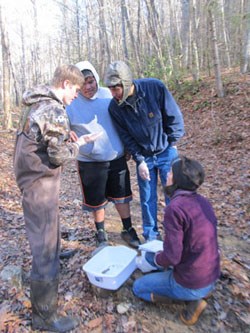They have mouthparts folded under their heads that can shoot out like a spear-thrower and grab their prey between vise-like "jaws". They can walk slowly or move quickly by jet propulsion. Aliens from Mercury? No…dragonfly nymphs from earthly streams, possibly with mercury inside them.
Mercury is a metal that is toxic to most life. Mercury gets into the environment through the burning of garbage-especially medical wastes-and some types of coal. Once it settles out of the atmosphere, it can remain in the environment for a very long time, either in a relatively harmless form or in its more toxic methylated form. Mercury contamination can lead to poisonous effects upon wildlife and human health, threatening the very resources the National Park Service is charged with protecting. In an effort to better understand the course of mercury contamination in national parks, the park has engaged park visitors, students, teachers, and citizen scientists are in a project to collect immature dragonflies (nymphs) and provide information for the national parks.
Why dragonfly nymphs? Dragonflies are sentinel species, meaning they are good indicators of mercury contamination in ecosystems, because they are predators and spend one or more years as aquatic nymphs. Small aquatic insects and worms are contaminated with mercury from the food they eat. As the dragonfly nymph's diet consists of large amounts of small aquatic insects and worms, it accumulates a high mercury level because the nymph cannot void the mercury effectively. This process is called mercury biomagnification. A one-time study by Dr. David Buchwalter of North Carolina State University in 2009 found a lot of variation in mercury concentrations in insects from different streams, with dragonfly nymphs from one site having twice the mercury as another.
Dr. Sarah Nelson, assistant research professor at the University of Maine, is working with parks in the eastern United States collecting dragonfly nymphs, and sends them to a lab for mercury analysis. She started her work in Acadia National Park (in Maine) using students and teachers to successfully collect the nymphs. She is now expanding her work to other National Parks including Great Smoky Mountains National Park.
A colleague of Dr. Nelson, Dr. Amy Riscassi, a postdoctoral research associate with the Oak Ridge Institute for Science and Education, and is the local expert scientist on this project. She worked with staff at Great Smoky Mountains National Park to select the best high, middle, and low elevation stream collecting sites. On a chilly November day, Dr. Riscassi, two park staff, Mr. Emory Rhoads (teacher at Cherokee HS), and six Cherokee HS students drove to Chasteen Creek, the mid-elevation site, in search for dragonfly nymphs. Students were given background information about the study before the search began. A sufficient number of nymphs were found at the site. Mercury concentrations in dragonfly nymphs for the Great Smoky Mountains National Park sites tend to be similar or slightly below the average for the sites sampled across northern New England. The ongoing research is investigating whether the dragonfly nymph's size, taxonomic family, or other factors explain part of the spread in the data.


